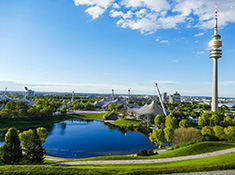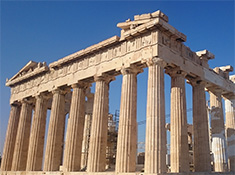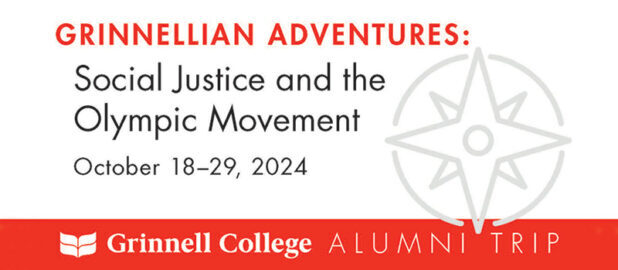Trip Itinerary
Itinerary (Oct. 18-29, 2024)
Friday, Oct. 18: Depart U.S.
Independent departure from the U.S. on your overnight flight to Europe.
Saturday, Oct. 19: Arrive Berlin
Check in to the NH Berlin Checkpoint Charlie or similar. Please plan to arrive by 1:00 p.m. Later this afternoon assemble in the hotel lobby to visit the Berlin Story Bunker Museum. This underground museum traces the history of the city of Berlin and includes information about Hitler’s rise to and fall from power. Meet with the Director of the Museum.
Enjoy a welcome dinner with the group.
[Dinner included.]
Sunday, Oct. 20: Berlin

Travel to the temporary Bauhaus Museum which was opened while the main museum is being worked on. Experimentation with presentation formats, cooperations, events, and new content is the main focus of the temporary museum. It is located in the listed landmark Haus Hardenberg building. It was built in 1955/1956 by the architect Paul Schwebes and is considered one of the most significant office and commercial buildings of postwar modernism in West Berlin.
Continue to the Berlin Olympic Stadium for a private guided tour. Close by is the Teufelsberg which played the role of its life in the drama known as the Cold War – as an American listening station. Return to central Berlin for a short sightseeing tour before a free evening.
[Breakfast included.]
Monday, Oct. 21: Nuremberg and Munich

Wander through the charming Altstadt, or Old Town of Nuremberg, which is divided in two by the Pegnitz River. Amongst its historical architecture, you’ll get to admire the Imperial Castle from which German Emperors ruled, the spectacular Gothic churches home to important German works of art, and the lively markets which have taken place for almost 700 years.
The tour will also take you to see the many reminders of the Nazi era, making a visit to the Nazi Party Rally Grounds, the largest Third Reich building left in the world, where your guide will reveal the details of the 20th century’s most famous judicial proceedings, known as the Nuremberg Trials, most notable for their prosecution of those responsible for the Nazi crimes of World War II.
Stop at the Nuremberg Palace of Justice. It was historic Courtroom where leaders of the Nazi regime had to answer for their crimes before the International Military Tribunal between November 20, 1945 and October 1, 1946.
Continue to Munich for a free evening.
Accommodations: Mercure Munich City Centre (or similar).
[Breakfast included.]
Tuesday, Oct. 22: Nuremberg and Munich

Continue on to discover Munich Olympic Park. A must for all sports fans: the tour with the Olympic lobby takes you through the VIP and team areas of the Olympic Stadium, i.e., to the locations of major sporting events such as the World Cup or the Olympics! You will take a look behind the scenes: in the VIP lounges and the guest of honor area, in the former changing rooms of the 1974 World Champions around Franz Beckenbauer.
End the day at the BMW Museum. Take a fascinating look at the history of the company, the brand, and the products. Around 125 of the brand’s most valuable and attractive automobiles, motorbikes, and engines are on display here. Explore the company’s role in the Nazi economy during the war.
[Breakfast and dinner included.]
Wednesday, Oct. 23: Dachau and Munich
This morning we travel to the Dachau Concentration Camp. We’ll pass through the same gate the prisoners once did, and pass through the courtyard, the entrance hall, the bathrooms, the prison, the barracks, the gas chamber, and the cremation ovens, as well as the different commemorative monuments.
Travel back to Munich for an afternoon at leisure.
[Breakfast included.]
Thursday, Oct. 24: Athens
Fly to Athens and make your way to our hotel at the Divani Palace Acropolis or similar. The rest of the afternoon/evening is at leisure as you begin to explore the city.
[Breakfast included.]
Friday, Oct. 25: Athens

Enter the Acropolis complex through the Beule Gate, composed of marble fragments from the destroyed monument of Nikias. This path was used every four years for the Panathenaic procession which honored Athena’s birth. Walk through the Propylaea which signifies the entrance of the Acropolis. Built by architect Mnesicles, the Propylaea was designed to instill the proper reverence in worshipers as they crossed over from the temporal world into the spiritual world of the Acropolis.
Continue to explore the Temple of Athena Nike, designed by Kallikrates in 427 B.C. The temple commemorates the Athenians victory over the Persians. This small temple stands on a platform that overlooks the islands of Saronic Gulf and used to house a statue of Athena. Marvel at the site of the Erechtheion (the Temple of Athena Polias), the most sacred location of the Acropolis. Legend has it that at this is the spot Poseidon plunged his trident into the rock, dramatically producing a spring of water whereas Athena created a simple olive tree, providing the fruit that remains the main staple of Greek society. Athena was declared the winner and the city was named Athens.
We will end our visit of the Acropolis exploring the Parthenon, an architectural masterpiece designed by Pericles and built in the fifth century B.C. Dedicated to the goddess Athena and inaugurated at the Panathenais Festival of 438B.C., the Parthenon served primarily as the treasury of the Delian League, an ancient alliance of cities formed to defeat the Persian incursion.
This evening enjoy dinner together at a local restaurant.
[Breakfast and dinner included.]
Saturday, Oct. 26: Athens

The stadium – built in the 4th century BC and restored for the first modern Olympic games in 1896 – was first used as a venue for the Panathenaic athletic contests. It’s said that at Hadrian’s inauguration in AD 120, a thousand wild animals were sacrificed in the arena. Later, the seats were rebuilt in marble by Herodes Atticus.
Continue to the Modern Olympic Games History Museum. Since 2004, the museum has been operating in the renovated building of the first Archaeological Museum built in 1985. In this magnificent neo-classical building archaeological finds related to the Olympic Games, coming from Olympia or from other museums in Greece, are displayed. The goal of the exhibition is to present the birth and evolution through time of the sporting and Olympic ideals. A building adjacent to the museum contains historical documents from the first excavations in Olympia by the German Archaeological School, which are continuing to this day.
[Breakfast included.]
Sunday, Oct. 27: Olympia
After breakfast, enjoy a scenic private bus ride to Olympia.
As a sacred place used regularly in religious ceremonies, as well as playing host to the Ancient Games, Olympia was at the center of Greek civilization. In addition to temples, there are the remains of all the sports structures erected for the Olympic Games in the archeological site.
Full of blood, passion, and extraordinary feats of athletic endeavor, the Olympic Games were the sporting, social, and cultural highlight of the Ancient Greek calendar for almost 12 centuries. For the first 250-plus years all the action took place in the sanctuary of Olympia, situated in the north-western Peloponnese. Pock-marked by olive trees, from which the victory wreaths were cut, and featuring an altar to Zeus, it was a hugely sacred spot.
The Games lasted a full five days by the fifth century BC and saw running, jumping and throwing events plus boxing, wrestling, pankration, and chariot racing. At least 40,000 spectators would have packed the stadium each day at the height of the Games’ popularity, in the second century AD, with many more selling their wares outside.
Visit the Stadium of Olympia, where the ancient Olympic Games and the Heraia, the women’s games in honor of Hera.
End the day with a tour of the Museum of the History of the Olympic Games of Antiquity
Transfer to the Hotel Europa Olympia for dinner and your stay this evening.
[Breakfast and dinner included.]
Monday, Oct. 28: Athens
Before returning to Athens for a final farewell, stop at the Athens Olympic Park restored to host the Olympic Games Athens in 2004.
Enjoy some last leisure time. This evening gather as a group for a farewell dinner.
[Breakfast and dinner included.]
Tuesday, Oct. 29: Athens
Depart Athens.
